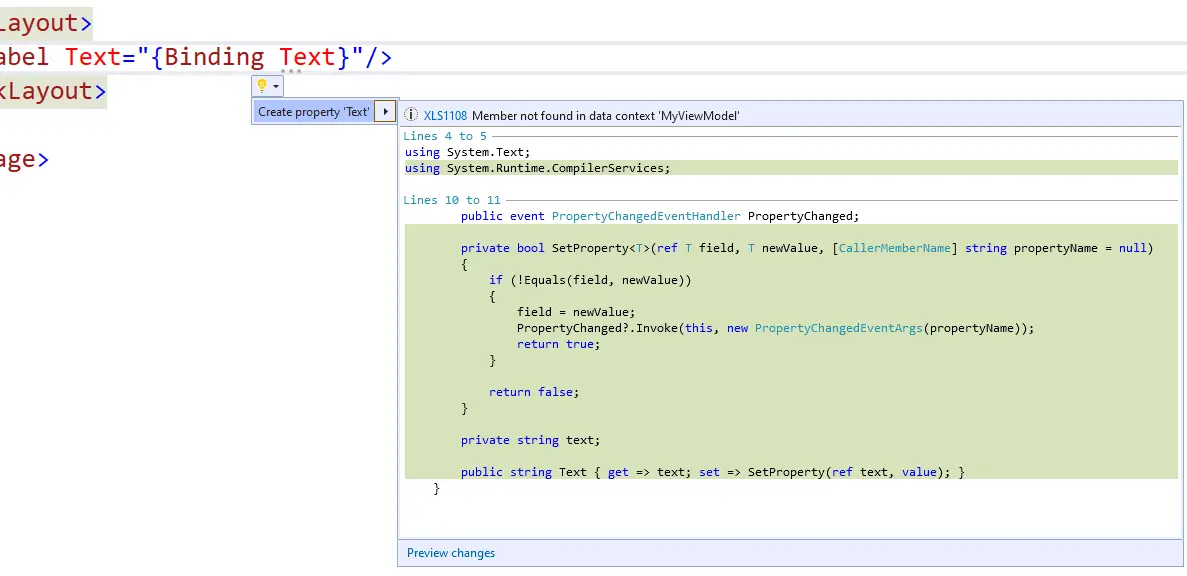Code Generation in Visual Studio: Accelerating Development

Code generation is a powerful feature in Visual Studio that can automate the creation of repetitive code, helping developers work faster and more efficiently. By utilizing code generation templates and snippets, developers can easily generate boilerplate code, class structures, and even entire blocks of code, saving valuable time and reducing the risk of introducing errors.

Key Benefits of Code Generation:

-
Rapid Development: Generate code quickly and effortlessly, accelerating development.
-
Consistency and Standardization: Ensure consistency and maintain coding standards across projects.
-
Error Reduction: Minimize the chances of introducing errors by eliminating repetitive manual coding.
-
Productivity Boost: Spend less time writing repetitive code, allowing for more creative and complex tasks.
-
Knowledge Transfer: Simplify onboarding and knowledge transfer among team members by providing standardized code templates.
How to Utilize Code Generation in Visual Studio:
-
T4 Templates: Visual Studio includes a powerful T4 template engine for sophisticated code generation tasks. Learn how to create custom T4 templates for specific code generation scenarios.
-
Code Snippets: Leverage built-in and user-created code snippets for common tasks. Customize and organize snippets, and learn to insert them quickly using IntelliSense.
-
Scaffolding: Visual Studio offers scaffolding capabilities for generating the basic structure of classes, controllers, and database models, among others. Explore how to use scaffolding to jump-start your development.
Practical Use Cases for Code Generation:
-
Generating Data Access Layer (DAL): Create data access classes and corresponding methods to interact with databases, saving time and reducing maintenance overhead.
-
Automating Unit Tests: Generate unit test stubs or complete tests automatically, facilitating the creation and maintenance of test suites.
-
ASP.NET MVC Controllers: Rapidly generate MVC controllers with the appropriate actions and views, simplifying the setup for web applications.
-
Generating Strongly Typed ViewModels: Create strongly typed view models easily, reducing the risk of data binding errors and improving the security of web applications.
-
Multi-Language Support: Utilize code generation to create localized resources, ensuring multilingual support in applications.
Best Practices for Effective Code Generation:
-
Choose the Right Tool: Select the appropriate code generation technique (T4 templates, code snippets, scaffolding) based on the complexity and scope of the task.
-
Maintainability and Readability: Ensure that generated code adheres to coding standards, is maintainable, and readable, making it easy for other developers to understand and modify.
-
Security Considerations: Be vigilant about security when generating code, ensuring that generated code does not expose vulnerabilities or inadvertently introduce security risks.
-
Version Control: Treat generated code as part of the codebase and include it in version control systems to allow for tracking changes and easy rollback if needed.
Conclusion:
Code generation in Visual Studio is a valuable tool that can accelerate development, improve code quality, and enhance productivity. Whether you are a seasoned developer or just starting, embracing code generation techniques can take your development skills to new heights. Explore the capabilities of code generation in Visual Studio, customize it according to your preferences, and reap the benefits of faster, error-free, and more standardized development.# Code Generation In Visual Studio: Accelerating Development
Executive Summary
Visual Studio’s code generation capability significantly enhances programmers’ productivity by expediting coding procedures, lowering the possibility of errors, and facilitating the production of high-quality code. The five main subtopics underscore these advantages:
-
Automated Code Creation: Programmers can construct high-quality code fast by utilizing predefined templates and scaffolding provided by Visual Studio, expediting the development process.
-
Immediate Refactoring: Facilitates rapid and efficient code modification, allowing developers to alter code swiftly and precisely while minimizing errors, thus saving time and effort.
-
Test-Driven Development (TDD) Integration: Allows developers to construct unit tests simultaneously while creating code, facilitating early detection of potential bugs and improving overall code quality.
-
Improved Code Maintenance: Streamlines the management of codebases as new features and changes emerge, enabling developers to modify and improve code more promptly and effortlessly.
-
Improved Collaboration: Facilitates effective collaboration among developers by standardizing code style and conventions, thereby reducing friction and improving communication when working on shared projects.
Introduction
Visual Studio’s code generation features streamline software development. By leveraging templates, snippets, and other automation tools, developers can save time, reduce errors, and produce higher-quality code. This article analyzes these features, highlighting the automated code generation, refactoring, test-driven development (TDD) integration, improved code maintenance, and the enhancements in collaboration they offer.
Automated Code Creation
-
Templates: Visual Studio’s extensive template library offers pre-built code frameworks for various project types, languages, and technologies. Programmers can quickly initiate projects, ensuring consistency and adherence to best practices.
-
Code Snippets: Developers can create and reuse code snippets for frequently used code blocks or constructs, accelerating development and minimizing repetitive coding.
-
Scaffolding: Generates the fundamental code structure for common scenarios, such as data access or user interface elements, reducing manual effort and accelerating project setup.
Immediate Refactoring
-
Quick Actions and Refactorings: Allows developers to restructure code promptly and effortlessly with automated refactoring tools. This helps enhance code readability, organization, and maintainability.
-
Code Contracts: Automatically verifies the preconditions and postconditions of methods and functions, improving code reliability and reducing the likelihood of runtime errors.
-
Generate from Usage: Automatically generates the declaration of methods, properties, and classes based on their usage in the code, reducing errors and streamlining development.
Test-Driven Development (TDD) Integration
-
Integrated Test Explorer: Developers can seamlessly create, execute, and debug unit tests within Visual Studio’s intuitive interface, facilitating rapid feedback loops for test-driven development.
-
Generate Unit Tests: Generates unit tests based on existing code, enabling developers to test code more thoroughly and with greater ease.
-
Mocking and Faking Frameworks: Supports mocking and faking frameworks that allow developers to test code in isolation, expediting the testing process and enhancing the reliability of unit tests.
Improved Code Maintenance
-
Code Cleanup: Automatically reformats and reorganizes code according to predefined style rules, improving code readability and maintainability.
-
Extract Method and Introduce Variable: These features enable developers to refactor code into smaller, more manageable functions and variables, enhancing code clarity and reducing complexity.
-
Find and Replace: Facilitates the rapid and precise location and modification of specific code elements, text, or symbols throughout the codebase.
Improved Collaboration
-
Shared Code Styles: Enables developers to establish and enforce consistent coding styles across the team, improving code readability and reducing friction during code reviews.
-
Code Reviews: Visual Studio’s built-in code review tools facilitate effective peer review of code changes, ensuring high-quality code and improved collaboration.
-
Live Sharing: Allows developers to collaborate on code simultaneously in real-time, fostering knowledge transfer and promoting teamwork.
Conclusion
Visual Studio’s code generation capabilities empower developers to create high-quality code efficiently, accelerating the development process while ensuring code quality. The comprehensive features, ranging from automated code creation to enhanced collaboration, streamline software development and promote effective teamwork. By leveraging these capabilities, developers can unlock the full potential of Visual Studio and deliver exceptional software solutions.
Keyword Phrase Tags:
- visual studio code generation
- code generation in visual studio
- visual studio automated code generation
- visual studio code refactoring
- visual studio test driven development

Hey there, this seems like an awesome feature! Can’t wait to try it out. Thanks for sharing!
This is nothing new, been there, done that! Try harder next time.
It’s important to note that this feature is only available in the latest version of Visual Studio. Make sure you have updated your software to enjoy the benefits.
I’m not sure I understand how this works. Can someone explain it to me in simpler terms?
Oh wow, a new way to write code. As if the old way wasn’t complicated enough.
Oh, look at that! Visual Studio is finally catching up with other IDEs. Better late than never, I guess.
Code generation? More like code generator! Haha, I’m just kidding. This seems like a great feature.
How long will it take for this feature to be available? I need it now!
I’ll believe it when I see it. Visual Studio has promised many things before that never materialized.
This is amazing! I can’t wait to try it out. Thanks for the heads up!
I’m not sure if I’m ready for this. I’ve been using the old way for so long.
What are the limitations of this feature? Are there any specific types of code that it doesn’t work with?
I’m already using this feature and it’s a game-changer! Highly recommended.
I’m a bit concerned about the potential bugs and glitches with this new feature. Has it been thoroughly tested?
OMG, this is the best thing since sliced bread! I can’t wait to use it on my next project.